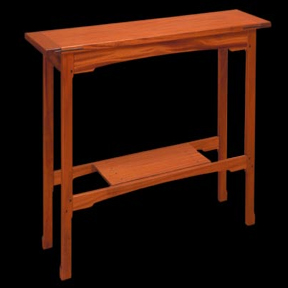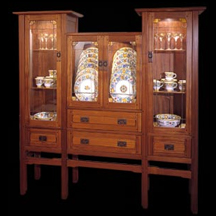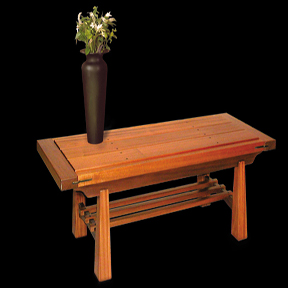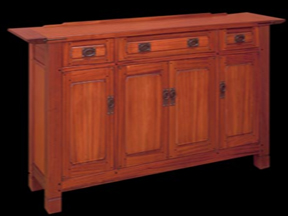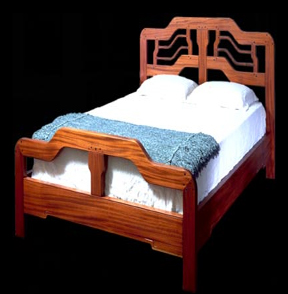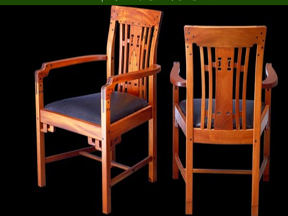
In a move eerily similar to a scene in the movie Sleepless in Seattle, Thomas Strangeland moved to Seattle and took up residence in a houseboat. There the similarity ends, for instead of architecture, Strangeland pursued a career that was to establish him as one of the finest furniture makers in the local woodworking scene.
These days, he exhibits his work regularly at the prestigious NW Fine Woodworking gallery, a co-op that showcases the very best woodworking the Pacific Northwest has to offer. Simply getting permission to exhibit there is a feat in itself and one that sets you apart as a fine craftsman. Tom’s journey started early with his very first “professional” repair job.
“My first professional repair,” Tom recounted, “was fixing a broken rocking chair when I was 10 years old. I took it into my woodshop in my basement, spent a day on it, and it worked. My neighbor was so thrilled that she wanted to pay me. I undercharged her. I think I asked for a quarter, and she gave me a dollar. Sadly, it has been that way ever since, and I suspect I still price my pieces too low.
“I was really drawn to make things even at a very early age, but working wood was hardly a family affair. My father, who was a salesperson in the diamond business, did not know which end of a hammer to use, so I pursued that on my own. When I was nine, we moved from Maryland to New York. The realtor who sold us the house made wire sculptures of tiny boats as his hobby. He showed me how he did it, and the first tool I learned to use, and bought, was a little Weller soldering iron. I made my first one just like his, then made more.
“Soon I started making things out of wood; in particular, model airplanes that fly. Because the wood was thin and light, I could do most of it with an X-Acto knife so I did not need a lot of tools. If you fly model planes, you soon realize that you spend more time repairing the planes than flying them, especially the fast combat planes that fly up to 100 mph. That meant building them stronger, and also meant that great precision was required to get them to fly accurately at those speeds.
“I finally took woodworking in my senior year of high school and enjoyed the time I got to spend in the shop. It was a new school, and they needed several items, like a speech podium. After quickly doing the basic things required by the course, I convinced the teacher to let me build the podium by showing him other things I had made. Fortunately, I have a knack for selling, and he agreed.
“I had some family out here, and moved in 1978 to Seattle, where my brother-in-law was rehabbing houses with a partner named Emmett Day. I learned carpentry at that job and bought a small houseboat to live in. Within a year, I went to college at the University of Washington, eventually earning a degree in Modern European History, and started working as a chef at a local bistro. During my first year of college, my son was born. It was 1980; I was 19 and growing up very fast.
“The next year, at the suggestion of his mother, I left my one-year-old son, bought a motorcycle, and took an extended six-month trip down the western United States and as far as Guatemala. I studied language and learned both regional culture and cuisine. I returned to UW the next fall, but by then our relationship had waned, and she had moved to a nearby island. I leased out the houseboat to cover the mortgage and rented a cheaper place near college.
“I spent one quarter abroad in France during my senior year. After graduation, I took my son, then four years old, to spend the summer with me in Normandy rebuilding a house owned by some friends. Clearly, I did not know what I was getting into. Fortunately, we were working for musicians, so it was low-key work. We only worked about four hours per day and lived in a house rented from a local peasant who frequently took care of my son.
“I returned in the fall and started working for Emmett Day, my brother-in-law’s former partner. By now he was making lavish furniture, and oddly enough, wooden flutes; in short, whatever captured his fancy. We made fabulous projects together in rare woods. In 1989, he died, but by then I had my own shop. I bought the remainders of his shop and went out on my own.
“Shortly after that, I had my first one-man show at a the NW Fine Furniture gallery in Seattle. I showed two Blacker armchairs in addition to many other pieces, mostly Northwest Contemporary style. That style is largely unadorned, uses clean, sharp lines, mixed woods for visual interest and contemporary styling and is, above all, entirely functional. In spite of the variety, all the orders I got from that show were for Greene and Greene inspired pieces.
“Three years later I did another one-man show, this time all Greene and Greene. That show was so successful that I decided to stick with Arts and Crafts. The next show, a year later, was even better. Everything sold out in two months, and I got a huge commission on top of it. By 1998, I had a son starting college at a very expensive school, and I decided to go where the sales were. Besides, doing the Greene and Greene pieces was rather easy, and frankly, a lot of fun.
When I asked Tom to talk about one of his favorite jobs, he told me about his “personal museum.” “I built two suites in the Disney Grand California Hotel,” he explained, “and it is like a little personal museum. It’s always there and I know where it is and that it will be taken care of. The only downside is that my friends and family would not be able to see those pieces because they could not afford to stay in those suites. To compensate, I got Disney to agree to put one of my pieces in the main lobby. That way my friends could see some of my work there.”
Like most highly accomplished woodworkers, he shares his expertise through teaching, and his philosophy about it comes straight from his own experiences. “Teaching, for me, involves giving back the same,” Tom insists. “Rather than attend school for woodworking, I would always find someone to teach me what I needed to learn. I knew I would often need an assistant, and even when I could not afford it I saw it as an important luxury. Besides, some day I will get too old to do the work. All that pointed to teaching, so I took on assistants.
“As I got more successful, around 1992, I got to the point when I had as many as five assistants. All were new to the field and had come to learn from me. At the moment, I am back down to only one, though that will change. Most of the others have gone on to their own shops, or decided to follow a different path and keep woodworking only as a hobby. It is a bit of a proving ground. When I teach at various schools, which I also do, I tell students this is a hard way to make a living. There are a lot of woodworkers who go into business, then back out of it.”
He did have some sage advice to offer for those who would follow in his footsteps.
“To make yourself a better person, do whatever you do assiduously. Though the end results are cherished moments, that is not really what it is about. What is important is the process; make every little joint and do every step the best way it can be done.”
Of course, there is one downside to working at what you love.
“I took my hobby and made it a career,” Tom admitted, “then realized I no longer had a hobby, so I chose one. Now I am back in school to study my hobby, wine making technology. My goal is to hand a good customer a bottle of fine wine with my label on it along with their furniture delivery. Of course, the same thing could happen again; I might end up making wine as a business. Then, I guess I will have to find yet another hobby.”
